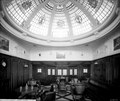SS Indarra
This article has multiple issues. Please help improve it or discuss these issues on the talk page. (Learn how and when to remove these messages)
|
 SS Indarra
| |
| History | |
|---|---|
| Name | Indarra |
| Owner | |
| Route | Australian coastal |
| Builder | William Denny and Brothers, Dumbarton |
| Yard number | 966 |
| Launched | 1 July 1912 |
| Completed | 6 November 1912 |
| Maiden voyage | 1913 |
| Out of service | 1 March 1942 |
| Homeport | Fremantle |
| Fate | Torpedoed and sunk on 1 March 1942 |
| General characteristics | |
| Class and type | Ocean liner |
| Tonnage | 9,735 GRT |
| Length | 450 ft (140 m) |
| Beam | 60 ft (18 m) |
| Draught | 32 ft 2.75 in (9.82 m) |
| Installed power | 1,378 NHP |
| Propulsion | Twin quadruple, 2 screws |
| Speed | 16 knots (30 km/h; 18 mph) |
SS Indarra was a passenger liner built for the Australasian United Steam Navigation Company (A.U.S.N. Co.). It was built in Dumbarton, Scotland in 1912 and was the largest ship on the Australian coastal trade prior to World War I. It was sold in 1920 and, after passing through several other owners, was sunk as a Japanese troopship in 1942.
Career
The SS Indarra was built by William Denny and Brothers, Dumbarton for the Australasian United Steam Navigation Company (A.U.S.N. Co.). In October 1920 the ship was purchased by the Compagnie Maritime Belge and renamed Pays de Waes. It had been planned for a River Plate service and it sailed in 1921 to Buenos Aires, Argentina.[1] The company also launched a Belgium–South Africa service using the vessel with Prince Leopold amongst passengers on the first voyage.[2]
In 1923, Pays de Waes was repossessed by A.U.S.N. Co. and sold to Osaka Shosen Kaisha and renamed Horai Maru. The accommodation was altered to 51 First Class, 123 Second Class and 553 Third Class (later increased to 669 Third Class).[3]
Fate
On 1 March 1942, the Horai Maru came under Allied air attack in the Battle of the Java Sea. In the midst of the battle, the Japanese cruiser Mogami fired a spread of Long Lance torpedoes with the American cruiser USS Houston as their intended target. The torpedoes missed the Houston and instead sank the minesweeper W-2 and Horai Maru, while also hitting the Ryuho Maru, Tatsuno Maru and Sakura Maru, with the latter three ending up beached.[4] The shot has been described as the best shot of torpedoes ever recorded, hitting five friendly ships at the same time.
The wreck of the Horai Maru was retrieved for salvage in 1947.[3]
Gallery
-
First Class Smoking Room
-
Second Class Dining Saloon
-
Indarra at Walsh Bay, Sydney
References
- ^ "List of Passengers of the Ship Pays de Waes to Argentina". Retrieved 2 January 2021.
- ^ "Other Africa Lines". Retrieved 2 January 2021.
- ^ a b Plowman, Peter (2007). Coast to Coast: The Great Australian Coastal Liners. Rosenberg Publishing, Kenthurst.
- ^ Branfill-Cook, Roger (2014). Torpedo: The Complete History of the World's Most Revolutionary Naval Weapon. Pen & Sword Books, Barnsley.
Bibliography
- Burchell, David (1971). The Bells of the Sunda Strait. Adelaide, Australia: Rigby.
- D'Albas, Andrieu (1965). Death of a Navy: Japanese Naval Action in World War II. Devin-Adair Pub. ISBN 0-8159-5302-X.
- Dull, Paul S. (1978). A Battle History of the Imperial Japanese Navy, 1941–1945. Annapolis, Maryland: Naval Institute Press. ISBN 0-87021-097-1.
- Grove, Eric (1993). Sea Battles in Close-Up: World War II, vol. 2. Annapolis, Maryland: Naval Institute Press. ISBN 0-7110-2118-X.
- Holbrook, Heber (1981). U.S.S. Houston: The Last Flagship of the Asiatic Fleet. Dixon, CA, USA: Pacific Ship and Shore.
- Hornfischer, James D. (2006). Ship of Ghosts: The Story of the USS Houston, FDR's Legendary Lost Cruiser, and the Epic Saga of Her Survivors. Bantam. ISBN 0-553-80390-5.
- Lacroix, Eric; Linton Wells (1997). Japanese Cruisers of the Pacific War. Annapolis, Maryland: Naval Institute Press. ISBN 0-87021-311-3.
- Schultz, Duane (1985). The Last Battle Station: The Story of the USS Houston. St Martins Press. ISBN 0-312-46973-X.
- Thomas, David A. (1968). The Battle of the Java Sea. New York: Stein & Day. ISBN 0-330-02608-9.
- van Oosten, F. C. (1976). The Battle of the Java Sea (Sea battles in close-up; 15). Naval Institute Press. ISBN 0-87021-911-1.



